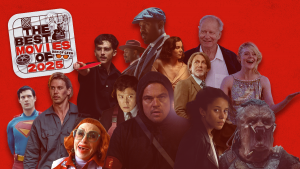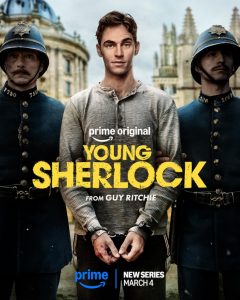
While the charisma of its three leads is undeniable, they are about the only thing marvelous in Nia Dacosta‘s The Marvels. While ostensibly a direct sequel to 2019‘s Captain Marvel, this film is burdened with multiple other characters that have been built up on Disney+ shows over the past few years. One of these shows provides the brightest spot of the film courtesy of Iman Vellani‘s Ms. Marvel, but The Marvels still feels like the 33rd film in the Marvel Cinematic Universe: an incomplete mishmash of multiple plot threads and character arcs that is so chopped down in editing that it doesn’t succeed at much.
The post-Endgame MCU has been a huge mixed bag, both critically and at the box office. COVID and now the two guild strikes have altered the release schedule of MCU films and shows so many times that one can’t help but feel a little bad for Kevin Feige and company. This era of the MCU had the potential to be the most planned-out portion of it, with the studio no longer having to worry about the uncertainty of making money. Instead, it seems the most chaotic. The MCU has still managed to conjure up a few great films, but most of them bear the signs of a twisted-around release schedule and what seems like an unclear picture for the greater story.
The Marvels does little to center you around any of its protagonists or their current place in the world. This deep into an interconnected universe, one would hope that world-building would be a strong suit, but instead it ends up being the weakest part of these films. The Marvels gives almost no detail on what Brie Larson‘s Captain Marvel has been up to since the first film, set 30 years in the past, or even in the years since Endgame. The details that are communicated are done via roughshod expository dialogue and flashbacks that doesn’t convey any of the depth the audience needs to root for these characters or relate to them. The irony is that this film bears all the burdens of being the 33rd movie in the MCU, but few of the bright spots that should come from it.
Samuel L. Jackson‘s Nick Fury is a supporting character again, coming off of the events of Secret Invasion, which were certainly life-altering for this character. Sadly, you wouldn’t know that show even happened, as there are only the barest of references to the Skrull plotline from that show, or from Captain Marvel, or any of the other small threads that were weaved into post-credit scenes over the past few years. Certain developments that Marvel herself would care about are not mentioned, and Fury is reduced to awkward comic relief, largely extraneous to the movie’s main events. What should be a strength of this long-running franchise is snuffed out.
And what are the film’s main events? Captain Marvel, Ms. Marvel, and Captain Rambeau (the grown-up daughter of Captain Rambeau from the first film) all start having entangled powers due to interacting with the jump points that allow intergalactic travel in the MCU. This entanglement results in the trio swapping places when they use their powers. This issue is complicated when the Kree Dar-Benn starts to use a space bangle (a pair to the one Ms. Marvel wields) to open wormholes and steal natural resources to heal the Kree home planet of Hala. Hala has been decimated since the first film due to the destruction of their AI leader, the Supreme Intelligence.
For a film that is cut to under two hours and often tries to be a light-hearted comedy, it is burdened and complicated by a plot that relies on underwritten backstory. The shame is that there are some robust themes that could be explored. The reason for Dar-Benn’s animosity towards Captain Marvel has depths to be plundered, and the exploration of Captain Marvel’s place in the MCU cosmos and her self-doubt could have been interesting. Larson’s Marvel also deals with guilt due to Rambeau’s feeling that her aunt Carol abandoned her as a kid and never returned to Earth. But these arcs are sadly reduced to small remarks here and there, and then wrapped up in a truncated, forced scenes of reconciliation. The villain herself comes across as super bland because we never spend sufficient time with her or learning about her. Zawe Ashton is given no time to make an impression.
The bright spots of the film are its energetic action sequences and the comedic charisma between the trio. While the cut makes the themes unfortunately muddled, this focus on an unlikely family unit works when Larson, Vellani, and Teyonah Parris are given room to play off each other. Vellani, especially, is a bright spot, bringing the same youthful energy that made her TV show work so well. The visual references to that show and inclusion of the parent characters, played well again by Mohan Kapur and Zenobia Shroff, are where the film really shines. As the trio learn to fight together and work around their swapping predicament, the action scenes take on a kinetic energy. The camera flies around and shows the various angles of the three working on concert, which is lots of fun.
The comedy is uneven on the whole. The film has a very strange sense of humor, and many jokes don’t land. Some are wonderfully quirky, including a visit to a planet where the inhabitants speak only in song. This planet is where South Korean acting star Park Seo-joon gets a role, though it seems sadly truncated by the nature of the cut. There is another MCU cameo that also seems reduced in the editing, and its reduction turns the scene so quickly that it is almost comical how poorly done and cheap it feels.
The shame of it all is The Marvels seemed like it had the potential to be much more than it was, more than the incomplete half-film it is. Everything is so cut down that little resonates, and Larson’s Captain Marvel barely feels like the main character of her own film. The dangling plot points of the first film are still dangling. The cohesiveness of the visual effects and flashbacks to certain events are touching and some of the film’s best material, but where a superhero film should be drawing wonder out of its audience, The Marvels instead leaves you wondering where all the marvel went.





